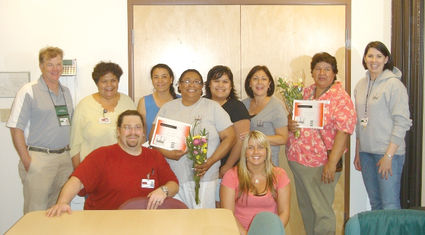Diabetes Prevention Program Progressing
Last updated 9/26/2012 at 9:48pm

Photo: KIC
Members of the KIC Diabetes Prevention Program are back row left to right: Bill Hardy, Behavioral Health Director/Health Educator; Shirley Snook, Becky Wagenius, C.J. Seludo class members; Helene Simpson, Program Recruiter; Merle Hawkins, class member; Leslie Wheeless Diabetes Program Director. Front Row Left to Right: Martin Smith, Dietician/Health Educator; Brehanna Johnson, Lifestyle Coach; Not pictured: Rebecca Magee, Pharmacist/Health Educator
KETCHIKAN, AK—Ketchikan Indian Community Diabetes Prevention Program (DPP) continues its good work, recently wrapping up a second 16-class session with nine participants. This year’s first session, also with nine members, experienced similar success. Graduation ceremonies for the second class were held on July 26 at the KIC Clinic.
The Diabetes Prevention Program is funded through the Special Diabetes Program for Indians (SDPI) initially authorized by Congress in 1997. The program, which concentrates on treatment of those with diabetes and prevention for pre-diabetics, is set to expire in 2013 unless re-authorized before then.
American Indians and Alaska Natives have the highest rate of type 2 diabetes in the nation. Since the program’s inception in 1997 through 2011 remarkable achievements have been made. The mean blood sugar level (A1C) has decreased to eight percent in 2011 from nine percent in 1996. This translates into a 40 percent reduction in diabetes related complications.
With budget deficits and a bulging federal debt there is mounting pressure to justify government funded programs. Clearly SDPI is having a profound and positive effect on KIC members participating in the program. Renewal of funding makes sense; “an ounce of prevention is worth a pound of cure.”
The DPP’s first 16 class session resulted in nine participants losing a cumulative 101 pounds with one person losing over 28 pounds. The recently concluded session achieved good results as well. A total of nearly 98 pounds was lost by nine participants with the largest weight loss of nearly 32 pounds. The age range is impressive; the youngest class member is 23 and the oldest is 81.
Judging from all of the smiles witnessed at the graduation ceremonies for the second session, learning to control portion sizes, losing weight and reacquainting oneself with the benefits of even moderate exercise and lifestyle changes you wouldn’t think losing a little weight could be so much fun! But it was. Becky Wagenius, one of the class members said, “I really enjoyed this class and would highly recommend it to others. It’s a lifestyle change. Every time I go to put something in my mouth I think about calories, fat grams and portion control and if I really need it. I enjoyed the instructors and other class members—it was a lot of fun. I want to send out a big thank you to everyone!”
According to the American Diabetes Association and the National Indian Health Board, diabetes is affecting young people at an alarming rate. Since 1990, American Indians and Alaska Natives aged 25-34 have seen a 161 percent increase of diabetes; similar increases have been noted in even younger age groups: 20-24 a 72 percent increase; 15-19 a 110 percent increase. If nothing is done, the likely outcome is a severe strain on medical care costs going forward not to mention the physical difficulties.
There is help for Ketchikan Indian Community members that are either pre-diabetic or already have the disease through the SDPI. If you’re pre-diabetic, which can be determined with a simple blood test, you can prevent the onset of disease with simple lifestyle changes. Eating healthy and increasing physical activity are two primary components of the DPP program.






